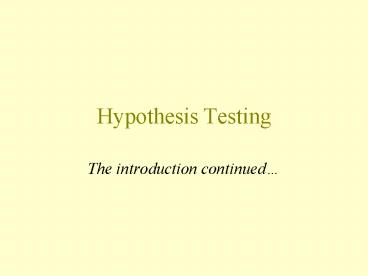Hypothesis Testing - PowerPoint PPT Presentation
1 / 10
Title:
Hypothesis Testing
Description:
Type I error: The null hypothesis is rejected when it is true. ... an extreme sample if the null hypothesis were true. ... We rejected the null hypothesis, i.e. ... – PowerPoint PPT presentation
Number of Views:46
Avg rating:3.0/5.0
Title: Hypothesis Testing
1
Hypothesis Testing
- The introduction continued
2
Errors in Criminal Trials
3
Errors in Hypothesis Testing
4
Definitions Types of Errors
- Type I error The null hypothesis is rejected
when it is true. - Type II error The null hypothesis is not
rejected when it is false. - There is always a chance of making one of these
errors. But, we will want to minimize the chance
of doing so!
5
Example Putting it all together
Population of many, many adults
Is average adult body temperature 98.6 degrees?
Or is it lower?
Average body temperature of 80 sampled adults is
98.4 degrees.
Sample of 80 adults
6
Example (continued)
- Specify hypotheses.
- H0 ? 98.6 degrees
- HA ? lt 98.6 degrees
- Make initial assumption ? 98.6 degrees
- Collect data Average body temp of 80 sampled
adults is 98.4 degrees. How likely is it that a
sample of 80 adults would have an average body
temp as low as 98.4 if the average body temp of
population was 98.6?
7
Using the p-value to make the decision
- The p-value represents how likely we would be to
observe such an extreme sample if the null
hypothesis were true. - The p-value is a probability, so it is a number
between 0 and 1. - Close to 0 means unlikely.
- So if p-value is small, (typically, less than
0.05), then reject the null hypothesis.
8
Example (continued)
The p-value can easily be obtained from
statistical software like MINITAB.
Test of mu 98.6000 vs mu lt 98.6000 The assumed
sigma 0.600 Variable N Mean StDev SE Mean
Z P Temp 80 98.4 0.67 0.0671 -2.80
0.0026
(Generally, the p-value is labeled as P)
9
Example (continued)
- The p-value, 0.0026, indicates that, if the
average body temperature in the population is
98.6 degrees, it is unlikely that a sample of 80
adults would have an average body temperature as
extreme as 98.4 degrees. - Decision Reject the null hypothesis.
- Conclude that the average body temperature is
lower than 98.6 degrees.
10
What type of error might we have made?
- Type I error here is claiming that average body
temp is lower than 98.6 when in fact it really
isnt. - Type II error here is failing to claim that the
average body temp is lower than 98.6 when it is. - We rejected the null hypothesis, i.e. claimed
body temp is lower than 98.6, so we may have made
a Type I error. (Boohoo!)































